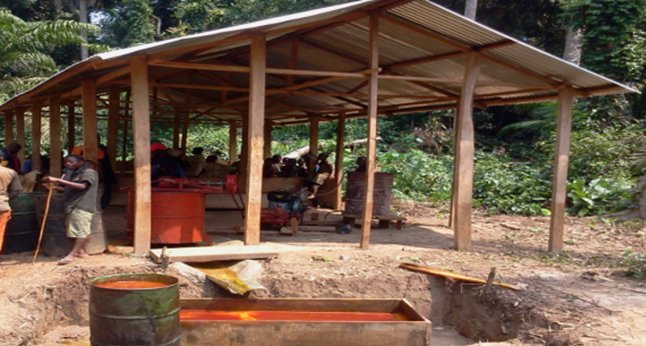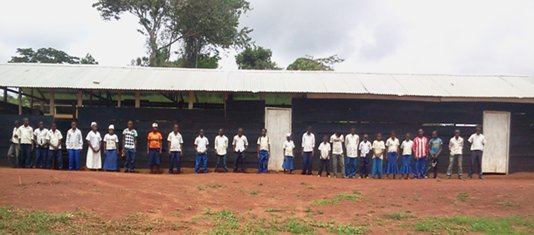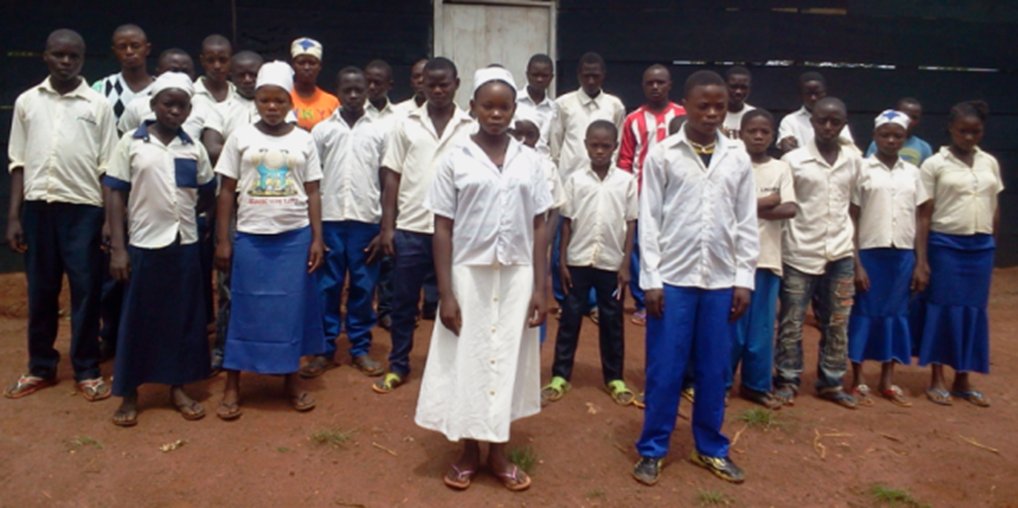Two of CAFEC strategies to reduce deforestation and forest degradation and associated GHG emissions consist in supporting ecologically sustainable artisanal use of natural resources and promoting sustainable livelihood alternatives as a substitute for unsustainable practices. In the Ituri LS these two strategies are used to achieve the dual goal of reducing deforestation while improving the livelihood of local communities in the landscape through a small grant program to local community organizations. One initiative supported by this scheme is improving access to secondary education by establishing of a secondary school in the village of Manya.
The village of Manya
Located 15 km east of the town of Mambasa, Manya is the largest village in the Bapwele ‘groupement’, ‘collectivité’ of Babila-Bakwanza in the territory of Mambasa. With a population of approximately 5,000 inhabitants and 1,200 households, Manya has an estimated 600 children of school age, 400 of which are enrolled at a local primary school. Roughly 200 students are estimated to be of secondary school age. Until recently, Manya did not have a secondary school and children at secondary school-age had to travel at least 9 km to reach the nearest secondary. Instead of walking this distance twice daily, most students had to leave their families to live with relatives or family friends in places where secondary school were located. This is a common situation in most rural areas, but it significantly increases student dropout rates (up to 60% or more), especially for teenage girls who end up pregnant due to the lack of family support. A local community organization sought to bring a solution to this problem that was hindering the prospect of getting an education for the children of Manya.
CAFEC funded ADPB’s initiative to improve the exploitation of natural resources in Manya
The ‘Association for the Development of the people of Bakwanza’ (ADPB) is community-based organization created in 2001 with the goal of improving the livelihood of its members. One of the livelihood activities chosen by ADPB is oil palm cultivation and the processing of nuts to produce palm oil. In 2011, some ADPB members established manual palm oil presses in the village.

Figure 1. Manual palm oil press commonly used in rural areas. Here is one of those used in Manya prior to current initiative.
These presses require at least two people to turn their wheels. Young men are usually employed for this job and paid by a portion of the oil production. Running these presses is a time-consuming and labor-intensive business, and productivity is relatively low. In addition, these presses must be located near streams as water is used to maximize palm oil extraction rate, resulting in substantial pollution for these water bodies (Fig. 1).
To further push towards the accomplishment of its goal, ADPB approached the Wildlife Conservation Society (WCS) with a project to establish a motor-powered oil palm press in Manya in 2013. After being judged financially viable and environmentally friendly, the project was funded for US$18,000 to purchase and install a motor-powered oil palm press in Manya (Fig. 2) and support the establishment of plantations of improved oil palm varieties.

Figure 2. ADPB’s motor-powered oil palm press in Manya. The press has a maximum capacity to produce 20,000 liters of palm oil per month.
The press was installed in July 2014 and it has produced approximately 12,700 liters of palm oil so far, well below its production capacity of 20,000 liters per month due to low production of nuts. A large portion of this production, 7,100 liters (56%), was owned by ADPB, while the rest belonged to individual households who utilized the services offered by the motor-powered press. The sale of the palm oil owned by the association earned it over US$5,300.
The community initiative serves to improve education in the village
In addition to the environmental impact of reducing the pollution of streams caused by manual palm oil presses in the village, the initiative has also shown important social and economic impacts. By using a motor-powered machine that is much more efficient than manual one, the project not only reduced the need for man power but it also improved the productivity of oil processing, increasing households return on investment in this activity. Furthermore, the association used part of the money earned to construct three classrooms and student desks for the local secondary school.
The support to the local secondary school is proving to be of tremendous importance for the community. A population survey conducted during the last school year showed there were roughly 200 students of secondary school age. Of these 50 (25%) were attending schools in nearby towns (Mambasa, Bunia, Beni, Butembo, etc.). These are primarily children of migrant families. Thirty-eight (19%) were enrolled


Figure 3. Classrooms and student desks constructed with financial support from ADPB initiative
at the local secondary school, and the remaining (56%) were dropouts. So the goal of the association is to reduce this high rate of dropout by offering full secondary education locally. Families will therefore have the opportunity to provide guidance and support to their children, instead of sending them away when they are still very young.
By improving access to secondary education, the initiative will also reduce the proportion of the individuals who will have no other choice than joining shifting agriculture when they become adults, eventually reducing pressure on forests by giving other opportunities and choices to the next generation.

Figure 4. Students of the Manya secondary school in front of their classrooms
The initiative is still in its infancy and the school only has three classes and 38 eight students and six (6) teachers this year. The project objective is to add a new classroom each year until the school has full program in 2017. This is an example of how well-organized artisanal exploitation of natural resources can contribute to improve local livelihoods while laying the ground for reducing pressure on forests in the long run.